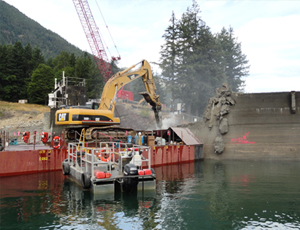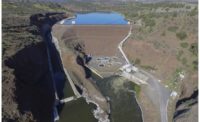
Contractors have started chipping away on the Glines Canyon Dam in Port Angeles, Wash., one of two dams on the Elwha River that are scheduled for removal as part of the largest project of its kind in the U.S. The 210-ft-high Glines Canyon dam and the 108-ft-high Elwha Dam are the two highest dams ever to be removed in the U.S. The project includes the removal of 24 million cu yd of sediment and debris and will restore 70 sq miles of natural habitat. Work on the project began on Sept. 15.
Prior to this, the largest dam removal in the U.S. was on the Sandy River, Ore., in 2007. There, the Marmot Dam was only 47 feet high, with one million cu yd of sediment. The general contractor, Barnard Construction Inc. of Bozeman, Mont., builds dams from the ground up across the country. “This time we are taking the dam down,” says Brian Krohmer, project manager. ”That brings a number of unknowns.”
Those unknowns include the composition of the sediment: No amount of modeling by the Bureau of Reclamation can predict what hides in the sediment, though it has predicted what will happen as the sediment flows down river.
However, Krohmer says removing the water from the dam is a tricky maneuver. If the water is removed too quickly, the amount of sediment can clog the channel and cause flooding. If crews let the water down too slowly, there could be insufficient force to carry the sediment down river.
Weather can either help or hinder the water flow. A glacier high in the Olympic Mountains, where 200 inches of precipitation fall annually, feeds the river. Rain, freezes and thaws at higher elevations can quickly change water levels. “It rained early in week, and the river went from 800 cubic feet per second [cfs] to 4,000 cfs in a few hours," Krohmer says. “We'll keep a close eye on weather and flow forecasts, and when a large event is expected, we will basically get our people and equipment out of the way, let the river run its course and return when the flows subside.”
Cost to remove the dams is estimated at $27 million, but the project total is $327 million. That total includes purchase of the two dams and hydroelectric plants from their previous owner, construction of two water treatment plants and other facilities to protect water users, construction of flood-protection facilities, a fish hatchery and a greenhouse to propagate native plants for revegetation. Privately funded projects required to accommodate additional water flow in the river are not included in that total.
Both dams are being removed primarily with hammer-equipped hydraulic excavators.
“At Glines [Canyon] Dam, we are working from a barge until the dam crest is wide enough to safely support equipment,” says Krohmer. “Drilling and blasting is our plan B in the event hammers are not achieving necessary production rates. We expect to remove approximately 60 to 100 cubic yards of concrete each production day at each site.” Barnard expects to remove a total of 37,000 cu yd of concrete, which will be recycled for use as aggregate by a local subcontractor.
At the Glines Canyon Dam, 17 ft of the middle section of the dam is being removed. Next, Barnard will alternate between the right and left sides of the dam. Then the rest of the middle will be removed by making small notches in it.
At the Elwha dam, Barnard is building a coffer dam in front of the right spillway. The next step is to remove the right spillway and then the cofferdam. The left spillway is up next for removal. Barnard will blast a new channel for the river on the left side. It will take up to three years to remove the dams because of drawdown restrictions, as well as weather and flow impacts.
“We are required to follow the reservoir draw-down restrictions in our contract of 1.5 feet per day [which increases to two feet per day at lower elevations],” says Krohmer “In addition, there are five and a half months out of each year … when we are not allowed to draw down the reservoirs in order to minimize the turbidity of the river while the salmon and steelhead are spawning downstream.” The National Park Service started a lengthy planning process for the project in the early 1990s, when a federal court ordered the dam removal as a result of a lawsuit over the dams’ relicensing.


Post a comment to this article
Report Abusive Comment